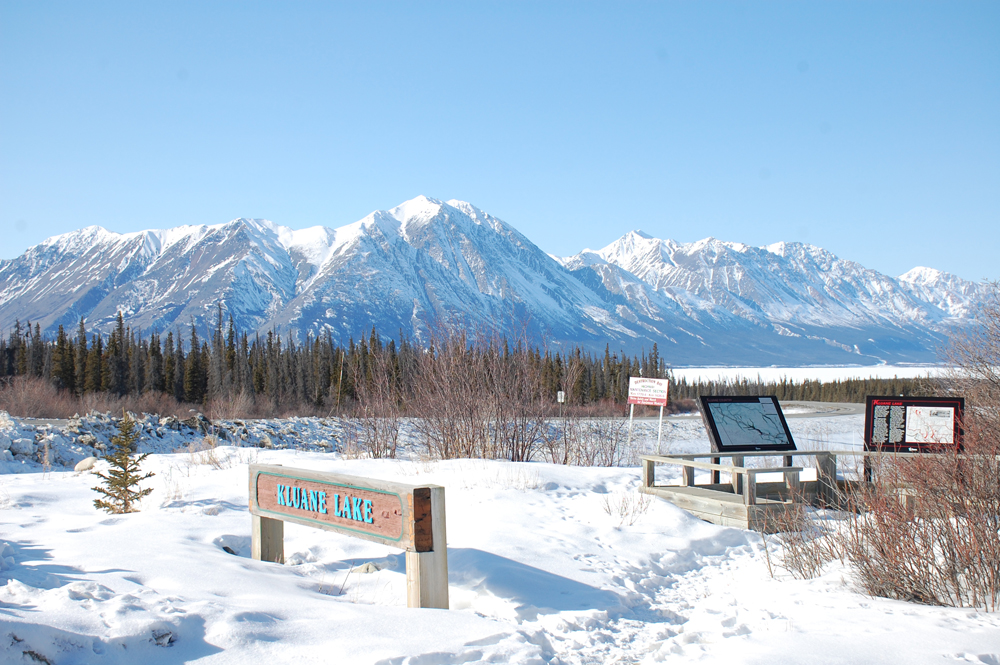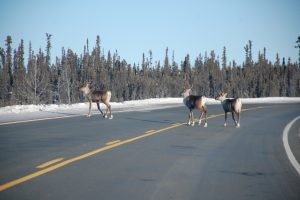Many people drive the Alaska Highway in winter. (A fair number of military personnel headed to or from bases in Alaska do this winter drive.) Whether it’s business or pleasure that prompts the long drive through this vast wilderness, first-timers always want to know: What’s it like?
First off, the Alaska Highway is open year-round, and winter drivers can expect a fair number of big rigs, along with local traffic, to be on the road. MILEPOST field editor Judy Nadon, who lives on the Alaska Highway near Whitehorse, YT, is one of those local drivers and winter is her favorite time of year. “I think everyone should come in the winter,” Judy says. “It’s so beautiful. Animal tracks are everywhere in the snow, the mountains are out of this world, there are no bugs and no crowds!”
But it is still winter and your vehicle should be equipped to handle temperatures that routinely dip to -22˚F/-30˚C, with lows to -48˚F/-44.5 ˚C in the Yukon.

You’ll also want to be sure you can handle keeping warm enough should you end up in a ditch or have a mechanical breakdown. Long-time MILEPOST® field editor Earl Brown, a year-round resident of Fort Nelson, BC, and a lifelong Alaska Highway resident, says “I always carry an extra long set of booster cables, tow rope, snow shovel and lots of warm clothing.” He also recommends installing a block heater in your vehicle so it can be plugged in for cold weather starts. “It’s a lot easier on your vehicle, and may mean the difference between starting your engine or not starting the morning after an overnight stop,” says Earl.
Judy agrees. “We all carry this equipment in our vehicles during winter. And just about every motel/hotel from Cache Creek, BC (on the West Access Route), north to Dawson

Creek and on up the highway, has plug-ins. I also insist that good winter tires are a must: Do not rely on all-season tires.”
Road conditions in winter can be excellent, with the highway surface smoothed of potholes with graded snow. ”Highway crews are generally quick to be out on the road plowing after snowfalls along the Alaska Highway,” says Earl. Difficult driving conditions include fog, blowing snow, drifting snow, snow on roadway, poor visibility, freezing rain, black ice, ice glaze and icy patches. Check road conditions at 511.alaska.gov; www.511Yukon.ca; and www.drivebc.ca.

Keep your driving segments short and confined to the daytime. Driving in the dark can be dangerous for winter drivers. Animals can and do leap out on to the highway without warning, but at least in daylight you may see them in time to stop. The Alaska Highway is lightly traveled at night in the winter, so if you should break down or have an accident at night, the wait time for help could be longer. Plan to depart at sunrise and be off the road by dark. And remember: Days are shorter in the North in winter.
Here are a few more suggestions from our field editors for winter driving:
“When the road signs say to slow down for dangerous curves, slow down!
“Be sure to travel on the top half of your fuel tank. Lots of places along the highway are only seasonal operations. There are about 120 to 150 miles between open-year-round service outlets.
“Phone ahead to confirm accommodations. The MILEPOST® log indicates those businesses that plan to be open year-round, but you don’t want to be counting on staying overnight some place only to find they’ve decided to close for the season after all. And keep in mind there are not many businesses along the Alaska Highway that are open 24 hours a day.
“Remember that there are long stretches of highway where there is no cell phone service.”

And a last piece of advice: “Plan to take a winter dip at Liard Hotsprings… It will probably be a highlight of your trip!”



Comments are closed.